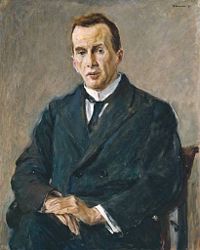
Richard Cassirer
Encyclopedia

Neurologist
A neurologist is a physician who specializes in neurology, and is trained to investigate, or diagnose and treat neurological disorders.Neurology is the medical specialty related to the human nervous system. The nervous system encompasses the brain, spinal cord, and peripheral nerves. A specialist...
who was born in Breslau. After receiving his medical doctorate in 1891 he became assistant at the psychiatric clinic in Breslau under Karl Wernicke
Karl Wernicke
Carl Wernicke was a German physician, anatomist, psychiatrist and neuropathologist. He earned his medical degree at the University of Breslau...
(1848-1905). In 1893 he went to Vienna
Vienna
Vienna is the capital and largest city of the Republic of Austria and one of the nine states of Austria. Vienna is Austria's primary city, with a population of about 1.723 million , and is by far the largest city in Austria, as well as its cultural, economic, and political centre...
and continued his studies under Richard von Krafft-Ebing (1840-1902) and Heinrich Obersteiner
Heinrich Obersteiner
Heinrich Obersteiner was an Austrian neurologist who was born in Vienna. In 1870 earned his doctorate from the University of Vienna, where he worked in the laboratory of Ernst Wilhelm von Brücke ....
(1847-1922). Later he became professor of neurology at the University of Berlin, where he worked closely with Hermann Oppenheim
Hermann Oppenheim
Hermann Oppenheim was one of the leading neurologists in Germany. He studied medicine at the Universities of Berlin, Göttingen and Bonn. He started his career at the Charité-Hospital in Berlin as an assistant of Karl Westphal...
(1858-1919).
As a clinical neurologist, Cassirer specialized on the anatomy
Anatomy
Anatomy is a branch of biology and medicine that is the consideration of the structure of living things. It is a general term that includes human anatomy, animal anatomy , and plant anatomy...
of the central nervous system
Central nervous system
The central nervous system is the part of the nervous system that integrates the information that it receives from, and coordinates the activity of, all parts of the bodies of bilaterian animals—that is, all multicellular animals except sponges and radially symmetric animals such as jellyfish...
and made contributions in his research of multiple sclerosis
Multiple sclerosis
Multiple sclerosis is an inflammatory disease in which the fatty myelin sheaths around the axons of the brain and spinal cord are damaged, leading to demyelination and scarring as well as a broad spectrum of signs and symptoms...
, encephalitis
Encephalitis
Encephalitis is an acute inflammation of the brain. Encephalitis with meningitis is known as meningoencephalitis. Symptoms include headache, fever, confusion, drowsiness, and fatigue...
and poliomyelitis
Poliomyelitis
Poliomyelitis, often called polio or infantile paralysis, is an acute viral infectious disease spread from person to person, primarily via the fecal-oral route...
. Among his written works was a new edition (1923) of Oppenheim's Lehrbuch der Nervenkrankheiten für Ärzte und Studierende.
In 1912 he first described a circulatory disease marked by an association of ovarian insufficiency and acrocyanosis with vasomotor-trophic disturbance of the skin, and disturbances of sensitivity caused by dysregulation of the vegetative nervous system which has been given the eponymic name of Cassirer's syndrome or Crocq-Cassirer syndrome.
In 1921, Dr. Cassirer was asked to give testimony regarding the mental condition of Soghomon Tehlirian
Soghomon Tehlirian
Soghomon Tehlirian was a native of Yerznka, an Armenian Evangelical survivor...
, who was accused of murdering Talaat Pasha. Cassirer maintained that Tehlirian was not sane when he carried out the crime because of his psychotic state caused as a result of his family being victims of a war-time massacre. Also Cassirer's portrait was painted by renowned artist Max Liebermann
Max Liebermann
Max Liebermann was a German-Jewish painter and printmaker best known for his etching and lithography.-Biography:...
in 1918, and later presented to the Tate Gallery
Tate Gallery
The Tate is an institution that houses the United Kingdom's national collection of British Art, and International Modern and Contemporary Art...
in London.
Written works
- Die vasomotorisch-trophischen neurosen. Berlin, 1901; 2nd edition, 1912.
- Die multiple Sklerose. Leipzig, 1905.
- Die beschäftigungsneurosen. Deutsche Klinik, volume 6, page 1; Leipzig and Vienna, 1906.
- Die vasomotorisch-trophischen Neurosen. In: Handbuch der Neurologie; volume 5, Berlin. 1914.
- Krankheiten des Rückenmarks und der peripherischen Nerven. In: Julius Schwalbe (1863-1930), publisher: Diagnostische und therapeutische Irrtümer und deren Verhütung. Leipzig, 1921; 2nd edition with Richard Henneberg (1868-1962), 1926.
- Vasomotorisch-trophische Erkrankungen. In: Friedrich KrausFriedrich KrausFriedrich Kraus was a Jewish Austrian internist. He is remembered for his achievements in the field of electrocardiography and his work in colloid chemistry.- Academic career :...
(1858-1936), Theodor BrugschTheodor BrugschTheodor Brugsch was a German internist born in Graz. He became an associate professor in 1910, and practiced medicine at the Charité Hospital in Berlin prior to, and after World War I. In 1917-19 he served with distinction as a physician with the 9th Army in Romania.From 1927 to 1935 he was a...
(1878-1963): Spezielle Pathologie und Therapie. Volume 10, page 3 [19 volumes, Berlin and Vienna, 1919-1929].

